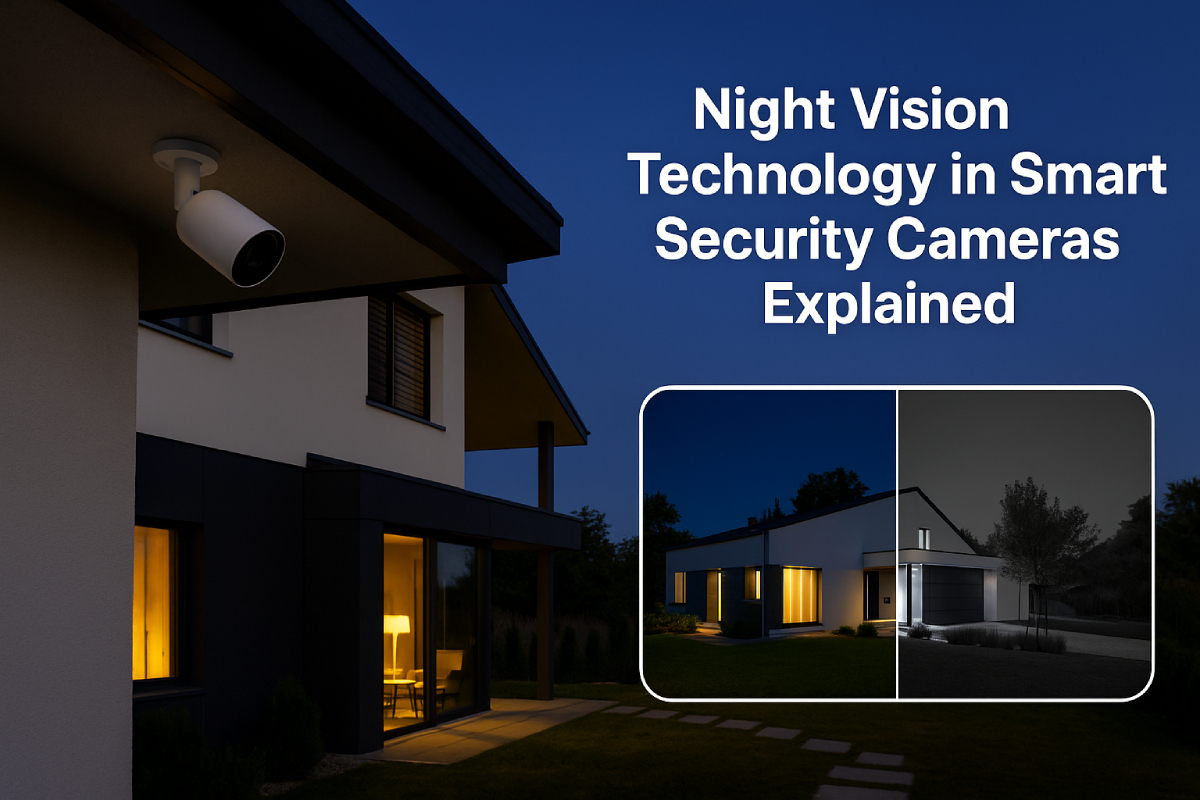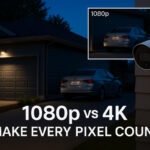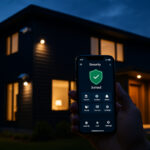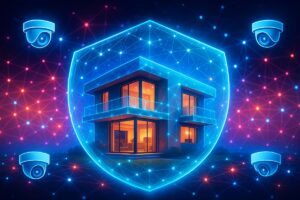In an age where threats can emerge at any hour, round-the-clock surveillance has become the backbone of modern smart security systems, ensuring constant vigilance over your home and assets.
In this article, we’ll demystify night-vision technology in smart security cameras—from infrared illumination and starlight sensors to thermal imaging—so you can understand the core principles, key benefits, and critical factors for selecting the perfect 24/7 protection solution.
Fundamentals of Night Vision
Below is a concise overview followed by detailed fundamentals of night-vision technology—complete with real-world crime statistics to underscore its importance in home security.
In essence, night vision encompasses both optoelectronic light amplification—harnessing minimal ambient or IR-illuminated light—and thermal detection, enabling cameras to capture clear images in total darkness.
This capability is vital because standard cameras fail when illumination drops, yet around 6 % of all crimes peak at midnight and more home burglaries occur under the cover of darkness, with nearly 60 000 incidents recorded at midnight in 2023.
By understanding these core principles and crime-driven use cases, homeowners can select smart security cameras that deliver true 24/7 protection.
What Is Night Vision?
Night vision refers to the suite of technologies that allow imaging beyond the visible spectrum by either amplifying scant visible light or detecting infrared radiation.
By amplifying faint ambient light or using IR illumination, specialized sensors convert low-light scenes into usable black-and-white—or even color—imagery. The two core methods are:
- Optoelectronic Image Intensification (light amplification): Classic image-intensifier tubes amplify photons through a microchannel plate before projecting a visible image, foundational in goggles and early security systems.
- Digital Image Enhancement: Modern cameras use DSP algorithms to amplify and de-noise existing light captured by CMOS sensors for clearer low-light video.
- Infrared (IR) Illumination: Arrays of IR LEDs emit 700–1 000 nm light invisible to the human eye; the reflected IR is captured to produce sharp monochrome footage.
- Low-Light (Starlight) Sensors: Back-illuminated CMOS sensors can operate at lux levels down to 0.0001, preserving natural color under minimal ambient light before switching to IR mode.
- Thermal Detection: Detects far-IR heat (8–14 µm) rather than reflected light, mapping temperature variations to reveal warm objects in total darkness—useful for perimeter monitoring.
Why Night Vision Matters in Security: Enhancing Safety After Dark
Darkness offers cover for intruders and reduces the effectiveness of standard cameras. Key crime-time statistics highlight this risk:
| Time of Day | Crime Rate (%) |
|---|---|
| Midnight | 6.0 % |
| Noon | 5.8 % |
| 5 PM | 5.8 % |
| 1–7 AM | 1.8 %–3.2 % |
More home burglaries occur at night, with midnight being the single most targeted hour—nearly 60 000 incidents in 2023—underscoring the need for effective night-vision surveillance.
Residential properties account for over 60 % of burglary offenses, making night vision a critical deterrent and detection tool.
By providing clear imagery in low or no light, night-vision cameras expand your detection range, reduce blind spots, and keep you informed when it matters most—after dark.
Infrared (IR) Illumination
Infrared (IR) illumination in smart security cameras harnesses LEDs at either 850 nm or 940 nm wavelengths to “light” scenes invisible to the naked eye, enabling clear black-and-white footage under zero ambient light.
850 nm LEDs deliver superior illumination distances—typically 30–50 m for built-in arrays and up to 165 m for specialized external illuminators—because camera sensors exhibit higher sensitivity near this wavelength, but they emit a faint red glow detectable by humans and wildlife.
In contrast, 940 nm LEDs operate in a true “no-glow” spectrum that’s virtually invisible, providing covert operation at the expense of shorter effective range (around 10–30 m) due to lower sensor quantum efficiency (amazon.com).
The choice between low-glow (850 nm) and no-glow (940 nm) IR ultimately hinges on the trade-off between extended coverage and stealthy deployment.
IR LED Technology: Wavelengths (850 nm vs. 940 nm) and Illumination Distance
Infrared LEDs centered at 850 nm and 940 nm form the backbone of night-vision lighting in modern security cameras. 850 nm LEDs lie close to the visible red spectrum, allowing camera sensors to capture more photons and thus achieve longer ranges—built-in camera arrays often reach 30–50 m, while high-power external illuminators can extend coverage up to 165 m.
Conversely, 940 nm LEDs emit deeper IR that is nearly imperceptible to the human eye, but camera sensitivity drops off at this wavelength, typically limiting coverage to 10–30 m in most applications (amazon.com).
Manufacturer specifications reflect these differences—for example, wide-angle 850 nm illuminators often rate at ~30 m, whereas 940 nm “invisible” dome cameras commonly list 30 m of range.
| Wavelength | Visibility | Typical Built-In Range | External Illuminator Range |
|---|---|---|---|
| 850 nm | Low-glow (faint red) | 30–50 m | Up to 165 m |
| 940 nm | No-glow (invisible) | 10–30 m | Up to 30 m |
No-Glow vs. Low-Glow IR: Trade-Offs Between Stealth and Range
No-glow IR systems use 940 nm LEDs that emit virtually no visible light, offering fully covert surveillance ideal for sensitive environments or wildlife monitoring—however, their shorter illumination distance can leave gaps in coverage over larger areas.
Low-glow IR employs 850 nm LEDs to extend effective range by roughly 30 %–50 % compared to no-glow alternatives, improving image clarity and detail, though the faint red glow may alert observers or wildlife to the camera’s presence.
When stealth is paramount—such as high-risk perimeter defense—no-glow IR is preferred; when maximum night-vision coverage and image fidelity take priority, low-glow IR with strategic concealment of illuminators delivers the best results.
Starlight and Low-Light Imaging
Starlight and low-light imaging elevate smart security cameras beyond simple infrared illumination by leveraging advanced sensor designs and color-preserving algorithms.
Back-illuminated CMOS sensors—exemplified by Sony’s STARVIS technology—amplify ambient light down to as low as 0.00001 lux, enabling clear, usable images even under starlight or streetlamp glow (amazon.com).
These sensors outperform traditional imaging tubes by boosting photon capture and reducing noise, delivering crisp detail in near-darkness.
Moreover, color retention in minimal light isn’t just a gimmick—it helps identify intruder clothing, vehicle colors, and contextual clues that monochrome infrared can’t provide.
Leading cameras maintain true-color imagery down to 0.004 lux before reverting to infrared mode, ensuring richer evidence and faster response in critical moments.
Starlight Sensor Principles: Back-Illuminated CMOS for Ultra-Low Lux Performance
Back-illuminated (BSI) CMOS sensors reposition wiring behind the photodiode layer, dramatically increasing fill factor and photon capture—key for ultra-low-light surveillance.
Sony’s STARVIS and STARVIS 2 platforms, for instance, deliver high sensitivity in both visible and near-infrared regions, with minimum lux performance down to 0.0001 lux (color) and even 0.00001 lux on specialized models (amazon.com).
Compared to older Exmor R sensors, STARVIS enhances image quality by converting faint starlight into noise-free electrical signals, preserving shapes and textures in challenging environments.
Low-light performance specs often read as “0.001 lux” for entry-level BSI cameras and “0.00001 lux” for premium starlight models—translating to usable color footage under a crescent moon.
Color Retention in Minimal Ambient Light: When and Why Color Matters at Night
While traditional IR-only cameras switch to monochrome once ambient light fades, starlight cameras leverage their BSI sensors and DSP algorithms to maintain color imagery until lux levels drop below a critical threshold—typically between 0.009 lux and 0.004 lux.
Full-colour night vision systems excel in scenarios like identifying vehicle paint or clothing hues, which can be pivotal for law enforcement or insurance claims.
| Ambient Light Level | Imaging Mode | Benefits |
|---|---|---|
| > 0.03 lux | Full-colour daylight | True-color detail for instant recognition |
| 0.009–0.004 lux | Colour starlight mode | Maintains hues under moonlight/streetlamps |
| < 0.004 lux | Infrared B/W mode | Maximum sensitivity in total darkness |
By preserving color deeper into nighttime conditions, smart cameras not only improve situational awareness but also reduce false positives—distinguishing, say, a passing animal from a human trespasser based on subtle color cues.
This capability empowers homeowners and security professionals to respond faster and with greater confidence, making starlight imaging a game-changer for 24/7 protection.
Thermal Imaging
Thermal imaging leverages far-infrared radiation to “see” heat, making it an invaluable tool for home security where darkness or obscurants can render standard cameras ineffective.
By detecting wavelengths in the 8–14 µm range, thermal cameras use microbolometer sensors to generate real-time heat maps—highlighting warm intruders as bright shapes against cooler backgrounds—even through fog, smoke, or complete darkness.
These systems convert invisible IR emissions into false-color or grayscale images, offering crisp perimeter and intrusion detection without any external light source.
However, thermal sensors typically trade off spatial detail for sensitivity—common resolutions span from 80×60 to 640×512 pixels—and professional units often start around $500, making them a premium addition alongside IR or starlight cameras.
In the sections below, we’ll explore precisely how thermal cameras map heat signatures and weigh their advantages and limitations for round-the-clock home protection.
Far-IR Heat Detection: How thermal cameras map heat signatures
Thermal cameras employ microbolometer sensors tuned to far-infrared wavelengths (8–14 µm), capturing the minute heat energy emitted by every object above absolute zero and converting those variations into electrical signals for image processing.
These uncooled microbolometers measure surface emissivity—how effectively a material radiates heat—allowing the camera to render warmer areas as bright regions and cooler zones as darker areas in either grayscale or customizable false-color palettes.
Advantages & Limitations: Detection through smoke/fog vs. resolution constraints
One of thermal imaging’s greatest advantages is its ability to maintain clear detection through obscurants like fog, smoke, rain, and complete darkness—conditions that typically thwart visible-light and IR-illuminated cameras.
However, these benefits come with trade-offs: thermal sensors generally offer lower spatial resolution—ranging from basic 80×60 up to 640×512 pixels—limiting fine detail recognition, and professional-grade units command a premium price point, often exceeding $500 for entry-level models.
| Feature | Performance & Trade-Offs |
|---|---|
| Detection Through Fog | Clear imaging in fog, smoke, rain, and snow—optical scatter does not impair IR transmission |
| Total Darkness Operation | Operates without any visible light, ensuring 24/7 coverage even in pitch-black environments |
| Typical Resolution | 80×60 to 640×512 pixels; lower spatial detail compared to optical or IR-LED systems |
| Cost | Entry-level thermal cameras start around $500; high-end models can exceed $2,000 |
| False-Alarm Reduction | High thermal contrast reduces triggers from moving shadows or lighting changes |
By understanding these core principles, homeowners can decide when to integrate thermal imaging into their security ecosystem—whether for critical perimeter defense, deterring intruders under cover of darkness, or supplementing IR/starlight cameras for the clearest, most reliable night-time surveillance.
Core Components and Operation
Here’s a concise summary of the core components that enable reliable night-vision performance, followed by detailed sections on each element:
Smart security cameras rely on three key systems to see in the dark: advanced image sensors (standard CMOS, scientific sCMOS, and uncooled microbolometers) that capture visible, near-IR, or thermal radiation; a mechanical IR-cut filter (ICR) that switches automatically for true day/night imaging; and tunable IR illumination modules whose range and intensity must be balanced against power consumption and image clarity.
Understanding how each component works—and the trade-offs involved—empowers homeowners and security professionals to choose the ideal camera for their environment, budget, and performance needs.
Image Sensors: CMOS, sCMOS, and Microbolometer Technologies
Modern smart cameras typically use one of three sensor types:
- CMOS (Complementary Metal-Oxide-Semiconductor) sensors are ubiquitous in consumer cameras, offering low cost, small size, and high frame rates but moderate low-light performance.
- sCMOS (Scientific CMOS) sensors build on CMOS designs with larger pixel wells, ultra-low read noise, and high dynamic range—ideal for critical low-light surveillance where detail at very low lux levels is required.
- Microbolometers are the heart of thermal imaging cameras; these uncooled detectors measure far-IR heat (8–14 µm) by sensing minute temperature changes on a vanadium-oxide or amorphous silicon array, producing heat-map imagery without any visible or near-IR light source.
| Sensor Type | Sensitivity | Spectral Range | Typical Use Case |
|---|---|---|---|
| CMOS | ~1 lux (color) | Visible + near-IR | General security, budget systems |
| sCMOS | 0.001–0.0001 lux (color) | Visible + near-IR | Premium low-light/starlight applications |
| Microbolometer | Heat-based (no lux rating) | 8–14 µm (thermal IR) | Perimeter, obscurant-penetrating detection |
IR-Cut Filter & Day/Night Switching
To maintain true-color images by day and high-contrast B/W at night, cameras employ a mechanical IR-cut filter (ICR) that automatically slides into place over the sensor:
- Day Mode: The ICR blocks near-IR, passing only visible light for accurate color reproduction under sunlight.
- Night Mode: When ambient light falls below a threshold, the filter retracts to admit IR wavelengths, enabling the sensor to use either built-in IR LEDs or ambient IR for monochrome night vision.
- Mechanics & Control: Typical ICR assemblies use a small motor or solenoid, drawing ~155–225 mA at 3.4–4.5 V to actuate a dual-pane filter, and switch within a fraction of a second.
- Benefits: Mechanical switching ensures minimal color cast at dusk/dawn and prevents IR bleed in bright conditions—outperforming electronic or static filters.
Illumination Range & Intensity
Built-in IR illumination modules must balance coverage distance, power draw, and image exposure:
- Range vs. Power: Typical onboard IR arrays consume 4–9 W, delivering 20–50 m of effective illumination at 850 nm; standalone IR floodlights can extend to 150 m+ but draw 30–100 W.
- LED Efficiency: Modern IR LEDs exhibit radiant-to-electrical efficiency factors of 6–35%, so a 10 W IR module might emit 0.6–3.5 W of IR light in the 850–940 nm band.
- Exposure Control: Many cameras modulate IR intensity dynamically to prevent overexposure at close range—improving contrast on nearby objects without washing out details.
- Trade-Offs: Higher-power IR extends reach but increases power bills, sensor heating, and potential detection by humans/animals (for 850 nm); using 940 nm LEDs improves stealth but reduces range by up to 50 %.
By optimizing sensor choice, filter switching, and IR illumination, you can tailor your night-vision solution for maximum clarity, coverage, and cost-effectiveness—ensuring reliable 24/7 security monitoring.
AI-Driven Analytics
Modern smart security cameras leverage on-device AI to transform passive surveillance into active protection: they classify objects at the edge with high accuracy, enforce virtual tripwires and tamper alerts to secure defined zones, and employ machine-learning filters to cut nuisance alarms by up to 90 %—all while minimizing bandwidth use and response latency.
Edge-Based Object Classification: People, Vehicles, Pets, and More
Edge-based analytics run deep-learning models directly on the camera, reducing cloud traffic by up to 80 % and slashing response times to milliseconds.
These systems automatically detect and classify moving objects—humans, cars, bicycles, animals, and even packages—enabling smarter alerts rather than generic motion triggers.
By processing frames locally, object classification engines can achieve over 95 % accuracy for people and vehicle detection in real-world settings.
| Category | Examples |
|---|---|
| People | Walking, standing, loitering |
| Vehicles | Cars, trucks, motorcycles |
| Animals | Pets, wildlife |
| Objects | Bags, packages |
Virtual Tripwires & Tamper Alerts: Pre-Defined Zones and Anti-Tampering Measures
Virtual tripwires let users draw custom lines or polygons on a video feed; any object crossing the boundary triggers an immediate alert, focusing attention on key entry points or perimeters.
AI enhances this by ignoring irrelevant crossings (e.g., swaying trees) and only notifying on targeted object types like people or vehicles.
Meanwhile, tamper alerts detect camera cover-ups, lens sprays, or angle changes—instantly notifying you of attempted interference and preventing blind spots.
| Feature | Description |
|---|---|
| Virtual Tripwire | User-defined line/polygon that triggers on specified object crossings |
| Tamper Alert | Detects lens obstruction, camera movement, or cover-up attempts |
Smart Alerts & False-Alarm Reduction: On-Device Machine Learning for Reliable Notifications
On-device AI filters contextual data—distinguishing pets from people, weather-driven motion, or shifting shadows—before issuing alerts, which can reduce false alarms by up to 90 % in commercial and industrial deployments.
In one case, a manufacturing facility saw monthly false alarms drop from 200 to 10 after adopting smart analytics, while a retail chain cut nuisance alerts by 68 %, saving $15 000 per year in response costs.
| Metric | Pre-AI False Alarms | Post-AI False Alarms |
|---|---|---|
| Manufacturing Site | 90 % of alerts | 10 % of alerts |
| Retail Chain | 68 % of alerts | < 5 % of alerts |
By combining edge-based classification, virtual tripwires, tamper detection, and powerful AI-driven filtering, modern smart cameras deliver highly accurate, context-aware surveillance—ensuring you’re only alerted to genuine security events when they happen.
Advantages, Limitations & Trade-offs
Each night-vision modality brings distinct strengths and trade-offs that hinge on your specific security needs. Infrared illumination delivers cost-effective, zero-light surveillance with clear monochrome imaging up to 50 m using 850 nm LEDs or up to 30 m with stealthier 940 nm variants.
Starlight cameras use back-illuminated CMOS sensors to preserve true-color footage in ambient light as low as 0.0001 lux—ideal for moonlit settings—but will revert to IR mode once illumination dips below critical thresholds.
Thermal imaging detects far-IR heat signatures through smoke, fog, or total darkness, offering reliable perimeter and obscurant-penetrating detection at the expense of lower spatial resolution (80×60 to 640×512 px) and a higher entry-level price point.
Selecting the optimal technology depends on deployment environment, desired detail (color vs. heat contrast), and budget, as each option presents unique performance, cost, and functionality considerations.
Comparison Table of Technologies (IR vs. Starlight vs. Thermal)
The following table compares key attributes of infrared illumination, starlight imaging, and thermal sensing for home-security applications.
| Aspect | IR Illumination | Starlight Imaging | Thermal Imaging |
|---|---|---|---|
| Imaging Principle | Reflective near-IR (700–1 000 nm) using IR LEDs | Amplification of ambient light via back-illuminated CMOS (0.0001 lux) | Far-IR heat detection (8–14 µm) via microbolometers |
| Light Dependence | None—operates in total darkness | Requires minimal ambient light; switches to IR in deep darkness | Independent of visible light—works day or night |
| Image Output | Monochrome B/W footage; no color | Full-color until ~0.004 lux, then B/W | False-color or grayscale heat maps—no visible-light imagery |
| Typical Range | 30–50 m (850 nm), 10–30 m (940 nm) | 20–40 m (dependent on sensor and lens) | 20–100 m+ (varies by lens and sensor) |
| Resolution | Matches camera sensor (e.g., 2–8 MP) | Matches camera sensor (e.g., 2–8 MP) | 80×60 to 640×512 px common; higher costs for finer detail |
| Color Capability | None | True-color until lux threshold | None (thermal contrast only) |
| Cost Tier | Entry-level (< $100) | Mid-range ($150–$300) | Premium (from $500+) |
Table data compiled from Reolink, SecurityCameraKing, Jet Hotel Solutions, Avigilon, and Teledyne FLIR.
Use-Case-Specific Trade-offs: Choosing Based on Environment, Detail Needs, and Budget
- Outdoor Residential Surveillance:
Starlight imaging shines under streetlamps and moonlight for color detail, IR provides reliable monochrome coverage up to 50 m, and thermal excels in fog or rain by detecting heat through moisture-laden air. - Indoor Low-Light Areas:
Garages and storage rooms benefit from starlight cameras capturing color down to 0.001 lux, while IR units suffice for simple B/W monitoring; thermal is reserved for detecting hidden heat sources or wiring issues. - Perimeter Defense & Wildlife Monitoring:
Thermal imaging reliably detects body heat through foliage and complete darkness, making it ideal for long-range perimeter fences and wildlife observation, whereas IR and starlight may falter without ambient light or in adverse weather. - Budget Considerations:
IR cameras are the most budget-friendly option, starlight systems represent a moderate investment, and thermal units require a premium budget—guiding purchases based on desired performance and return on investment.
Selecting and Deploying Night-Vision Cameras
Here’s a concise overview of the key considerations when selecting and deploying night-vision cameras, followed by detailed best practices and a maintenance schedule:
In choosing and installing night-vision cameras, start by matching the technology (IR, starlight or thermal) to your use case—whether home monitoring, commercial premises or long-range perimeter defense—while aligning features and coverage with your budget tier (from sub-$50 entry-level to $600+ thermal systems).
Proper placement—mounting at 10–12 ft with a slight downward tilt, clear line of sight, and reliable power (PoE or solar)—ensures optimal coverage and minimal glare.
Finally, regular upkeep—cleaning lenses, inspecting IR-cut filters, securing cables, and updating firmware quarterly—preserves image clarity and system security over time.
Assessing Use Cases
- Home Security: Residential setups focus on covering entry points (doors, windows, driveways) with outdoor IR or starlight cameras offering 30–50 m of range. The average home-security camera costs about $168, making mid-range starlight models a cost-effective deterrent.
- Placement under eaves or soffits protects units from weather and UV exposure while providing clear night-time coverage.
- Commercial Premises: Retail stores, warehouses, and parking lots often deploy bullet or PTZ cameras with robust housings and IR/starlight sensors for high-resolution surveillance over 50 m. These systems frequently include advanced analytics and weatherproof ratings (IP66+) for reliable operation in harsh environments.
- Perimeter Monitoring: Large-area or perimeter defense benefits from long-range IR illuminators (100–200 ft) or thermal cameras that detect heat signatures through foliage, fog, and total darkness. Long-range IR arrays deliver up to 60 m of coverage, while thermal imaging provides detection beyond 100 m irrespective of light conditions.
Budget and Cost Considerations
Choose a system tier that balances features, range, and analytics needs:
| Tier | Price Range | Key Features | Example Models & Pricing |
|---|---|---|---|
| Entry-level | < $50 | Basic 1080p IR night vision, indoor use | Blink Mini ($49.99) (amazon.com) |
| Mid-range | $100–$300 | Outdoor IR 30–50 m, starlight color mode | Tapo MagCam Solar ($149.99) Vivint Wired ($200-$400) |
| Premium | > $500 | Thermal imaging, AI analytics, long range | Entry-level thermal ($600+) |
Installation Best Practices
- Height & Angle: Mount cameras at 10–12 ft above ground, tilting down no more than 30° to optimize field of view and minimize glare from IR or streetlights.
- Positioning: Cover all vulnerable zones—front door, back entry, driveway and blind spots—using overlapping fields of view. Under-soffit mounting shields units from weather and reduces maintenance.
- Power & Connectivity: Prefer Power over Ethernet (PoE) for single-cable power/data runs and reliable uptime. For remote locations, solar-powered options with battery backup ensure continuous operation.
- Avoid Obstructions: Keep vegetation, signage, and structural overhangs clear of the lens to preserve IR illumination and prevent false triggers.
Maintenance Tips
Regular maintenance sustains performance and longevity:
| Task | Frequency | Notes |
|---|---|---|
| Clean Lenses & Housings | Monthly | Wipe with soft, lint-free cloth; avoid harsh solvents |
| Inspect IR-Cut Filters | Quarterly | Ensure mechanical ICR moves freely; check for haze or debris |
| Check Cables & Power | Quarterly | Tighten connections; verify PoE injector or solar charge |
| Firmware & Software Update | Quarterly | Install latest patches for security and new features |
| Performance Test | Biannually | Verify night-vision clarity, IR range, and analytics alerts |
Adhering to these guidelines will help you deploy a night-vision system that delivers reliable, 24/7 protection tailored to your environment, budget, and security needs.
Future Trends and Innovations
Emerging security camera innovations are converging into three key trends that will define the future of night-vision and home security: hybrid night-vision systems that seamlessly blend IR illumination, starlight low-light imaging, and full-color night vision for uninterrupted coverage.
AI-enhanced image processing using embedded deep-learning models to suppress noise and reveal hidden details in near-darkness without fabricating data.
and the tight integration of cameras into IoT-driven smart-home ecosystems—leveraging standards like Matter—to create unified, automated security solutions across devices and platforms.
Hybrid Night-Vision Systems: Combining IR, Starlight, and Color Night Vision
Hybrid night-vision cameras automatically switch among multiple imaging modes—standard color in daylight, starlight low-light in moonlit or streetlit conditions, and IR illumination in complete darkness—to ensure continuous, high-fidelity monitoring without user intervention.
These systems detect scene brightness and object movement, then activate the optimal illumination source—visible LEDs, IR LEDs, or sensor amplification—for that scenario, reducing false triggers and power waste.
As a result, homeowners enjoy full-color footage down to lux levels as low as 0.004, then crisp monochrome IR imaging out to 50 m or more, all in a single device.
AI-Enhanced Image Processing: Deep Learning for Low-Light Clarity
Modern cameras embed CNN-based noise reduction and enhancement models directly on dual-NPU hardware to clean up grainy footage and boost object recognition accuracy in real time—without generating fictitious details.
This on-device approach preserves forensic integrity by ensuring every enhanced pixel corresponds to actual sensor data, avoiding the hallucinations common with generative AI.
Systems like Hanwha Vision’s Wisenet 9 use AI-NR to remove noise at the pixel level while retaining edge definition, improving low-light clarity by up to 60 % compared to traditional denoising.
Industry leaders also train models on diverse nighttime datasets—covering street, indoor, and rural scenarios—to adaptively tune brightness, contrast, and detail extraction for each environment.
Integration with IoT & Smart Homes: Unified Security Ecosystems
The rise of IoT standards like Matter and growing support in hubs and routers enable seamless interoperability among cameras, smart locks, sensors, and alarm systems—forming cohesive security networks that automate responses across devices.
For example, a triggered motion sensor can instruct compatible cameras to start recording, activate smart lights, and send an alert through a single smart-home app, all without manual orchestration.
The smart home security camera market, valued at $12.53 billion in 2025, is projected to grow at a 19.23 % CAGR through 2034, driven by this IoT-enabled convergence.
Manufacturers are also embedding local AI inference and edge computing in security hubs—such as TP-Link’s Matter-ready HomeBase—to reduce cloud dependency and latency while maintaining privacy.
By embracing hybrid imaging, AI-driven enhancement, and IoT integration, tomorrow’s smart security cameras will offer homeowners unmatched clarity, intelligence, and convenience—delivering true 24/7 protection within unified smart-home ecosystems.
Conclusion
In conclusion, night-vision technology in smart security cameras spans infrared illumination, starlight low-light imaging, and thermal detection—each delivering reliable 24/7 protection but with distinct trade-offs in range, detail, and cost to suit varied security needs.
By assessing your environment, desired image fidelity (color vs. heat contrast), and budget, you can confidently choose the optimal solution—whether entry-level IR for basic coverage, starlight sensors for richer low-light color, or thermal cameras for obscurant-penetrating perimeter defense—ensuring the right night-vision system for your security goals.
FAQs
What’s the difference between 850 nm and 940 nm IR?
850 nm LEDs deliver longer range (30–50 m) with a faint red glow, while 940 nm “no-glow” IR is invisible but reaches only 10–30 m.
How low can starlight cameras capture color?
Top starlight sensors retain true-color footage down to 0.0001 lux—about the light of a half-moon.
Is thermal imaging worth the cost?
Thermal excels through fog, smoke, and darkness, detecting heat signatures beyond 100 m, but starts at $500+ due to sensor costs.
How do AI analytics reduce false alarms?
On-device AI classifies objects (people, vehicles, pets) with >95 % accuracy and filters out 80 % of irrelevant motion, cutting false alerts by up to 95 %.
What maintenance keeps night-vision cameras reliable?
Monthly lens cleaning, quarterly IR-cut filter checks, biannual performance tests, and firmware updates preserve clarity and security.
Main Tips
- Mount cameras at 10–12 ft with a ≤30° downward tilt for optimal coverage.
- Choose 850 nm IR for range or 940 nm IR for stealth based on site requirements.
- Opt for starlight sensors (0.0001 lux) when color recognition is critical.
- Integrate AI classification to cut false alarms by 90 %.
- Perform quarterly firmware updates and ICR checks to maintain clarity and security





















